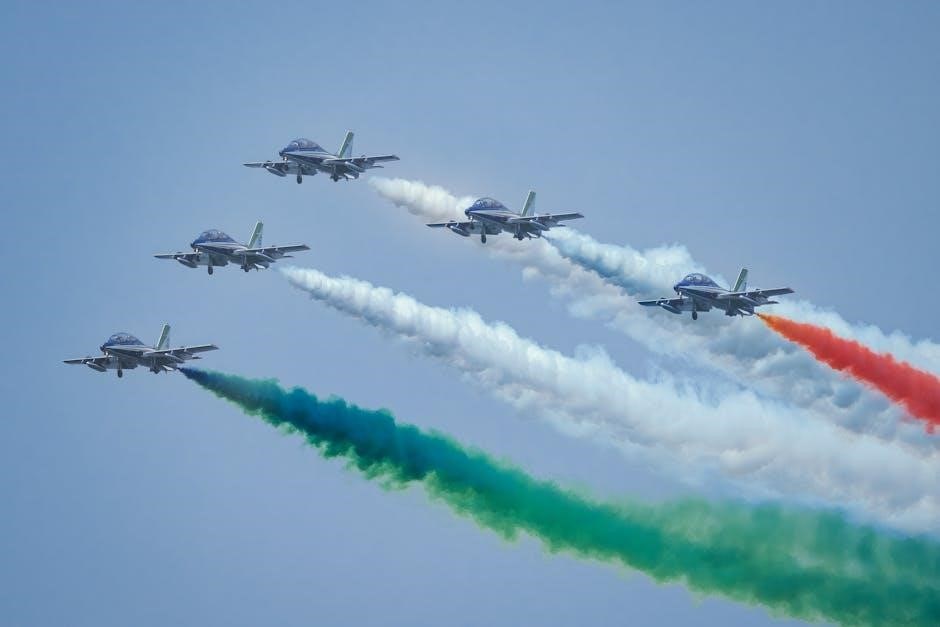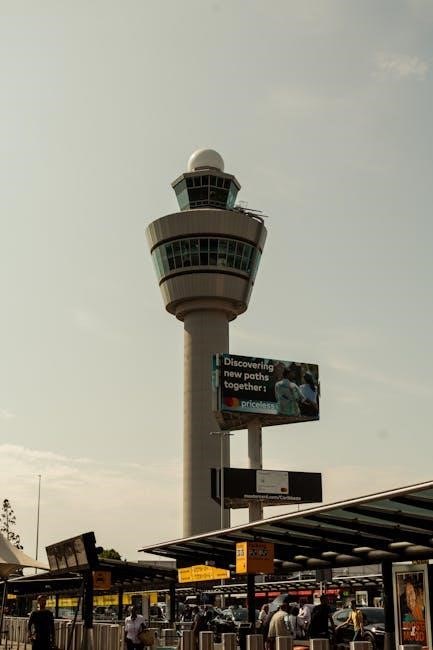Instrument Flight Rules (IFR) enable pilots to fly safely in low-visibility conditions without visual ground references, relying on instruments and navigation aids for precise flight control and decision-making.
1.1 Definition and Purpose of IFR
Instrument Flight Rules (IFR) are a set of regulations governing flight operations when visual references to the ground are unavailable. IFR allows pilots to navigate safely in low visibility, such as in clouds or at night, by relying on instruments and navigation aids. Its primary purpose is to ensure safe and efficient flight operations under instrument meteorological conditions (IMC), providing structured procedures for takeoff, en-route flight, and landing.
1.2 Historical Development of IFR

Instrument Flight Rules (IFR) originated in the early 20th century due to the need for safer flight in poor weather. The 1930s saw the introduction of basic instruments like altimeters and heading indicators. Post-WWII advancements in radar, VOR, and DME systems revolutionized IFR. The 1970s brought GPS integration, enhancing navigation accuracy. Modern IFR incorporates advanced avionics, automation, and global standards, ensuring safer and more efficient flight operations under all conditions.
1.3 Importance of IFR in Modern Aviation
IFR is critical in modern aviation, enabling flights in diverse weather conditions, enhancing safety, and improving operational efficiency. It allows pilots to navigate precisely using instruments and navigation aids, reducing dependency on visual references. This capability is vital for commercial aviation, military operations, and general aviation, ensuring timely arrivals and departures. IFR also supports global air traffic management, making it indispensable for maintaining the complexity and volume of modern air travel.
Key Instruments for IFR Flight
Essential instruments include the altimeter, heading indicator, and GPS, enabling precise navigation and altitude control during flight, ensuring safety in low-visibility conditions.
2.1 Primary Flight Instruments
Primary flight instruments are crucial for IFR flight, including the altimeter, airspeed indicator, heading indicator, and attitude indicator. These tools provide essential data for altitude, speed, direction, and aircraft orientation, enabling pilots to navigate safely without visual references. The altimeter measures altitude, while the airspeed indicator shows speed. The heading indicator displays direction, and the attitude indicator shows pitch and roll. Together, they form the foundation for instrument flying, ensuring precise control in all weather conditions.
2.2 Navigation Aids (VOR, DME, GPS)
Navigation aids like VOR (VHF Omnidirectional Range), DME (Distance Measuring Equipment), and GPS are essential for IFR flight. VOR provides directional guidance, helping pilots determine their position relative to waypoints. DME measures distance from a ground station, enhancing navigation accuracy. GPS offers precise location data, enabling direct routing and approach procedures. Together, these tools allow pilots to navigate safely in instrument meteorological conditions, ensuring accurate course tracking and adherence to flight plans.
2.3 Approach and Landing Instruments
Approach and landing instruments are critical for safe IFR operations. The Glide Slope Indicator provides vertical guidance during approach, while Localizer systems offer lateral alignment with the runway. RNAV and GPS systems enable precision approaches, even at airports without ILS. Additionally, Decision Height and Decision Altitude indicators help pilots make safe landing decisions. These instruments ensure accurate alignment and altitude control, reducing workload during critical phases of flight and enhancing overall safety in low-visibility conditions.

IFR Checklist and Procedures
The IFR checklist ensures thorough pre-flight preparation, taxi, takeoff, and en-route procedures, while approach procedures guarantee safe landing under instrument conditions, minimizing errors and enhancing safety.
3.1 Pre-Flight Preparation
Pre-flight preparation is critical for safe IFR operations. Pilots must conduct a thorough weather briefing, review NOTAMs, and ensure all navigation and communication equipment is functional. Fuel calculations, navigation logs, and aircraft performance checks are essential. A detailed aircraft inspection, including instrument and avionics systems, must be completed. Additionally, pilots should verify weight and balance, ensure proper documentation, and review the flight plan. This systematic approach ensures readiness for departure and compliance with IFR requirements, minimizing risks during the flight.
3.2 Taxi and Takeoff Procedures

During taxi, pilots must monitor ATC instructions and maintain situational awareness, ensuring compliance with taxi clearances. Prior to takeoff, the aircraft must be configured correctly, with flaps and trim set as needed. The instruments, including altimeter and heading indicator, should be cross-checked. Communication with ATC is crucial, confirming takeoff clearances and any last-minute instructions. A smooth transition to instrument flight follows, with pilots focusing on maintaining altitude and heading while climbing to the assigned altitude. Adherence to procedures ensures a safe and efficient departure under IFR conditions.
3.3 En-Route and Approach Procedures
En-route, pilots monitor navigation aids like VOR and GPS, ensuring adherence to the flight plan. Altitude and heading adjustments are made as instructed by ATC. Upon approaching the destination, pilots transition to approach procedures, configuring the aircraft for landing. Instrument approaches, such as ILS or RNAV, require precise monitoring of glide slope and lateral deviation. Timely communication with ATC and adherence to approach clearances are critical. Safe execution of these procedures ensures a controlled and efficient arrival under IFR conditions, minimizing risks and enhancing overall flight safety.
IFR Navigation Log
An IFR Navigation Log records flight details such as ceiling, visibility, wind, fuel, and airport advisories. It helps monitor progress, fuel consumption, and weather conditions.
4.1 Components of an IFR Navigation Log
An IFR Navigation Log includes essential details such as ceiling, visibility, wind direction, fuel consumption, and airport advisories. It also records altimeter settings, approach procedures, and navigation waypoints. Pilots use this log to monitor flight progress, track fuel usage, and stay updated on weather conditions. Accurate entries ensure compliance with ATC requirements and enhance situational awareness during flight. The log serves as a critical tool for both pre-flight planning and real-time navigation adjustments, ensuring safe and efficient flight operations under IFR conditions.
4.2 How to Complete an IFR Navigation Log
To complete an IFR Navigation Log, start with pre-flight planning by plotting the route and listing waypoints. During flight, monitor fuel consumption, track progress, and update weather conditions. Record altimeter settings and any deviations from the planned route. Note approach procedures and ATC instructions. Ensure all entries are legible and accurate to maintain compliance and enhance situational awareness. Post-flight, review the log for completeness and accuracy, ensuring it reflects the actual flight conducted under IFR conditions.
4.3 Common Errors to Avoid
Common errors in IFR navigation logs include incorrect waypoint entries, miscalculations of fuel consumption, and failure to update altimeter settings. Pilots often overlook recording weather deviations and approach procedures. Incomplete or illegible entries can lead to non-compliance issues. Additionally, neglecting to cross-verify with ATC instructions or omitting critical details such as holding patterns or course intercepts can compromise situational awareness. Regular review of logs helps identify and mitigate these errors, ensuring accurate and compliant documentation for safe IFR operations.

IFR Phraseology and Communications
Clear and concise communication is critical under IFR. Pilots must use standardized phraseology, ensure accurate readbacks, and promptly respond to ATC instructions to maintain safe operations.
5.1 Standard IFR Phraseology
Standard IFR phraseology ensures clear and concise communication between pilots and air traffic control (ATC). It includes specific terms like “Cleared to land” or “Descend and maintain 5,000 feet.” Pilots must use precise language to confirm instructions, such as “Wilco” for “Will comply” or “Roger” for acknowledgment. This uniform terminology minimizes miscommunication and enhances safety. Phrases like “Holding short” or “Taxing to runway 27” are essential for clarity. Adhering to these standards is critical for efficient and safe IFR operations, as outlined in the AIM and ATC procedures.
5.2 Communication Failure Protocols
In the event of a communication failure during IFR flight, pilots must follow specific protocols to ensure safety. These include squawking 7600 on the transponder to alert ATC. If experiencing a two-way radio failure, pilots should continue flying the last assigned route and altitude. Visual signals, such as flying a standard traffic pattern, may be used if landing at an uncontrolled field. These procedures help maintain situational awareness and minimize risks until communication is reestablished or alternative actions are required.

5.3 Emergency Procedures
In case of an emergency during IFR flight, pilots must prioritize safety by declaring an emergency with ATC, using “Mayday” or “Pan-Pan” as appropriate. Activating emergency locator transmitters (ELTs) and following aircraft-specific emergency checklists are critical. Pilots should maintain situational awareness and communicate their intentions clearly. If unable to land at the intended airport, diversions to alternate fields with suitable conditions are necessary. Emergency procedures emphasize quick decision-making, adherence to protocols, and effective communication to ensure passenger and aircraft safety.

Recency of Experience Requirements
Pilots must complete six instrument approaches, holding procedures, and course tracking within six months to remain IFR current, ensuring proficiency in both real and simulated conditions.

6.1 Instrument Approaches and Holding Procedures
Instrument approaches and holding procedures are critical for maintaining IFR proficiency. Pilots must complete six instrument approaches within six months, either in actual IMC, simulated conditions, or a flight simulator. Holding procedures, such as intercepting and tracking courses, must also be practiced regularly. These requirements ensure pilots remain skilled in navigating without visual references, adhering to precise altitudes and headings. Proficiency in these tasks is essential for safe IFR operations, particularly in challenging weather conditions or complex airspace environments.
6.2 Tracking and Intercepting Courses
Tracking and intercepting courses are essential skills for IFR pilots, requiring precise navigation and situational awareness. Pilots must demonstrate the ability to accurately follow assigned headings and radials, ensuring alignment with procedure turns and final approach segments. Regular practice, either in real conditions or simulations, helps maintain proficiency in course interception, a critical component of instrument flying. This skill is vital for adhering to ATC instructions and safely executing instrument approaches, ensuring seamless navigation through controlled airspace and arrival at designated waypoints.
6.4 Recency Requirements for IFR Flight
Pilots must meet specific recency requirements to remain qualified for IFR flight. Within the preceding 6 months, they must complete 6 instrument approaches, holding procedures, and course intercepts. These can be conducted in actual IMC, VMC with a view-limiting device, or a flight simulator/FTD. This ensures pilots maintain proficiency in critical IFR skills, such as navigation and approach techniques, and remain compliant with aviation regulations to safely operate under instrument flight rules.
Aircraft-Specific IFR Procedures
IFR procedures vary by aircraft type, with specific protocols for single-engine, multi-engine, and rotary-wing aircraft, ensuring safe and efficient flight operations under instrument conditions.
7.1 Single-Engine Aircraft Procedures
Single-engine aircraft IFR procedures emphasize precise instrument handling, with a focus on maintaining altitude and course using primary flight instruments. Pilots must be vigilant about navigation aids like VOR and GPS, ensuring accurate tracking. Pre-flight checks are critical, including verification of all systems and navigation equipment functionality. During takeoff, climbs, and approaches, strict adherence to checklists is essential to minimize risks. Additionally, managing fuel efficiency and monitoring weather conditions are vital for safe IFR operations in single-engine aircraft.
7.2 Multi-Engine Aircraft Procedures
Multi-engine aircraft IFR procedures require careful management of engine performance and fuel distribution to maintain optimal climb gradients and efficiency. Pilots must monitor engine instruments closely, ensuring symmetric thrust and proper fuel flow. IFR operations in multi-engine aircraft often involve more complex systems, such as autopilot and autothrottle, which simplify workload but demand thorough understanding. Additionally, pilots should be prepared for engine failure scenarios, applying appropriate procedures to maintain control and continue safely under IFR conditions. Regular training and proficiency checks are essential for mastering these advanced techniques.
7.3 Rotary-Wing Aircraft Procedures
Rotary-wing aircraft IFR procedures involve unique challenges due to their hover and autorotation capabilities. Pilots must master instrument approaches in confined areas, often requiring precise altitude and airspeed control. IFR operations in helicopters demand heightened situational awareness, especially during low-visibility takeoffs and landings. Additionally, rotorcraft-specific instruments, such as the radar altimeter, play a critical role in maintaining safe margins. Regular practice of autorotation procedures under IFR conditions is essential to ensure readiness for emergencies while operating in instrument meteorological conditions (IMC).
Safety Tips for IFR Flight
Adhering to pre-flight checks, maintaining situational awareness, and staying vigilant for system malfunctions are crucial for safe IFR operations, ensuring optimal flight management and passenger safety.
8.1 Pre-Flight Safety Checks
Conducting thorough pre-flight safety checks is essential for IFR flights. Review weather forecasts, NOTAMs, and aircraft performance data. Ensure all primary and navigation instruments, including GPS and VOR, are functioning correctly. Verify fuel levels and emergency equipment availability. Complete a detailed aircraft inspection, focusing on lights, tires, and control surfaces. Ensure proper communication equipment setup and test transponder functionality. Adhere to the IFR checklist for single-engine or multi-engine aircraft, as specified in the pilot’s manual, to guarantee readiness for safe instrument flight operations.
8.2 In-Flight Monitoring and Adjustments
During IFR flight, continuous monitoring of instruments and navigation aids is crucial for maintaining situational awareness. Regularly check altimeters, heading indicators, and GPS for accuracy. Monitor fuel consumption and adjust flight plans as necessary. Stay alert for changes in weather conditions and be prepared to execute contingency plans. Use VOR and DME to track progress along the route and ensure compliance with ATC instructions. Adjust power settings and pitch to maintain desired altitude and airspeed, ensuring efficient and safe flight progression through instrument meteorological conditions.
8.3 Post-Flight Procedures
After landing, complete the IFR navigation log and submit the flight plan if required. Conduct a thorough post-flight inspection, checking for any system malfunctions or damage. Secure the aircraft, ensuring all instruments are powered down and navigation aids are turned off. Review the flight performance to identify areas for improvement and update logs for future reference. Properly store all IFR-related documents and ensure compliance with regulatory requirements for post-flight reporting.
Instrument Flight Rules (IFR) are essential for safe and efficient flight in low-visibility conditions, ensuring pilots can navigate accurately using instruments and established protocols.
9;1 Summary of Key Points
Instrument Flight Rules (IFR) are critical for flying in low-visibility conditions, relying on instruments and navigation aids like VOR and DME. Pilots must adhere to strict procedures, including pre-flight checklists, communication protocols, and recency requirements. Understanding IFR phraseology and emergency protocols is essential for safe operations. Regular training and familiarity with aircraft-specific procedures ensure compliance with regulations. IFR enables precise navigation and decision-making, making it a cornerstone of modern aviation safety.
9.2 Final Thoughts on IFR Flight
Instrument Flight Rules (IFR) are a cornerstone of modern aviation, enabling safe flight in challenging conditions. Mastery of IFR requires dedication, continuous training, and adherence to strict protocols. By leveraging advanced instruments and navigation aids, pilots can ensure precision and safety. Regular recency requirements and proficiency checks are vital for maintaining expertise. As aviation evolves, IFR remains indispensable, blending traditional skills with cutting-edge technology to meet the demands of today’s airspace.
